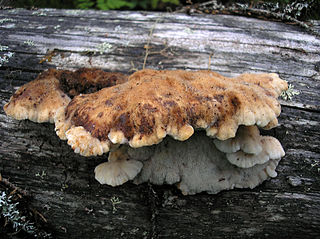
The Mycocaliciaceae are a family of seven genera and about 90 species of fungi in the order Mycocaliciales.

Calicium is a genus of leprose lichens. It is in the family Caliciaceae, and has 40 species.

Anaptychia is a genus of lichen-forming fungi in the family Physciaceae. Anaptychia species have brown, thin-walled spores with a single septum, and a prosoplechtenchymatous upper cortex.
Roseograndinia is a fungal genus in the family Phanerochaetaceae. It is a monotypic genus, containing the single crust fungus species Roseograndinia rosea, recorded from tropical east Africa and from New Zealand.

Candelariaceae is a family of lichen-forming fungi in the order Candelariales. It contains seven genera and about 73 species.

Chaenothecopsis is a genus of about 40 species of pin lichens in the family Mycocaliciaceae.

Phaeocalicium is a genus of fungi in the family Mycocaliciaceae. The genus was circumscribed in 1970 by German lichenologist Alexander Schmidt, with Phaeocalicium praecedens assigned as the type species.

Nigroporus is a genus of poroid fungi in the family Steccherinaceae. The genus was circumscribed by American mycologist William Alphonso Murrill in 1905. Nigroporus has a pantropical distribution. The genus name combines the Latin word niger ("black") with the Ancient Greek word πόρος ("pore").

The Caliciaceae are a family of mostly lichen-forming fungi belonging to the class Lecanoromycetes in the division Ascomycota. Although the family has had its classification changed several times throughout its taxonomic history, the use of modern molecular phylogenetic methods have helped to establish its current placement in the order Caliciales. Caliciaceae contains 39 genera and about 670 species. The largest genus is Buellia, with around 300 species; there are more than a dozen genera that contain only a single species.

Metuloidea is a genus of five species of fungi in the family Steccherinaceae. The genus was circumscribed by New Zealand-based mycologist Gordon Herriot Cunningham in 1965. The type species is M. tawa, a fungus originally described by Cunningham as a species of Trametes. Formerly classified in family Meruliaceae, Metuloidea was moved to the Steccherinaceae in 2016, following prior research that outlined a revised framework for the Steccherinaceae based on molecular phylogenetics.

Metuloidea murashkinskyi is a species of tooth fungus in the family Steccherinaceae. It is found in Europe and Asia, where it causes a white rot on the wood of deciduous trees.
Butyrea is a genus of two species of crust fungi in the family Steccherinaceae.
Antella niemelaei is a species of poroid crust fungus in the family Steccherinaceae.

Amylocystis lapponica is a species of bracket fungus in the family Fomitopsidaceae, and the type species of genus Amylocystis. It produces medium-sized, annual fruit bodies that are soft, and have a strong, distinct smell. The fungus is a saprophyte that feeds on coniferous wood of logs lying on the ground, and causes brown rot. It is a rather rare species that only occurs in old-growth forest.
Taitaia is a single-species fungal genus in the family Gomphillaceae. It was circumscribed in 2018 to contain the species Taitaia aurea, a lichenicolous (lichen-dwelling) fungus. This species is characterized by aggregated ascomata with yellow margins, and salmon-red discs that originate from a single base. It is known only from a few sites in Kenya's tropical lower-mountain forests, where it grows on thalli of the lichen Crocodia.
Bruceomycetaceae is a small family of fungi in the order Lecanorales. It contains two genera, each of which contains a single species.
Resinogalea is a single-species fungus genus in the family Bruceomycetaceae. Both the genus and its species Resinogalea humboldtensis were described as new to science in 2016 by Jouko Rikkinen and Alexander Schmidt. The fungus, found in New Caledonia, grows on the semi-hardened resin exuded by the endemic tree species Araucaria humboldtensis.
Brunneocarpos is a fungal genus in the family Mycocaliciaceae. It is a monotypic genus, containing the single species Brunneocarpos banksiae. The fungus grows on the cones of Banksia plants in Australia.
Chaenothecopsis penningtonensis is a resinicolous fungus found on Picea mariana bark flakes. Found in Minnesota and Wisconsin, Chaenothecopsis penningtonensis is newly introduced in 2020 by ecologists Otto Gockman and Steven Selva. As of 2022, this species have also been observed in Alberta, Canada by ecologist Jose Maloles.
Protothelenella is a genus of fungi in the family Protothelenellaceae. It contains 11 species, some of which form lichens. Protothelenella species have a crustose thallus with spherical to pear-shaped, dark brown to blackish perithecia. Microscopic characteristics of the genus include bitunicate asci with an amyloid tholus, and ascospores that are colourless and contain multiple internal partitions. Some species grow on acidic substrates including rocks, soil, bryophytes, plant detritus or rotten wood. Other species are lichenicolous (lichen-dwelling), growing on species of Solorina, Peltigera, Pseudocyphellaria, or Cladonia.








